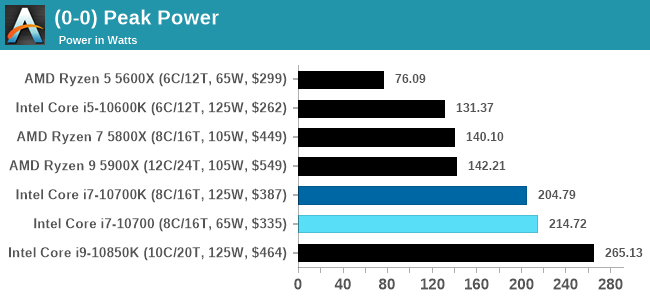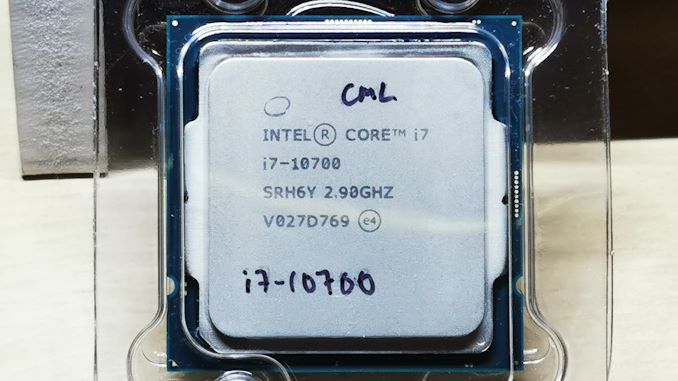Intel Core i7-10700 vs Core i7-10700K Review: Is 65W Comet Lake an Option?
by Dr. Ian Cutress on January 21, 2021 10:30 AM EST- Posted in
- CPUs
- Intel
- Core i7
- Z490
- 10th Gen Core
- Comet Lake
- i7-10700K
- i7-10700
Conclusion: TDP is Not Fit For Purpose
In years gone by, processors were sold with a single frequency and power rating. It was very quickly realized that if a processor could effectively go to sleep, using either lower voltage or lower frequency (or both) then a lot of idle power could be saved. Going the other way, processor designers realized that for temporary short bursts, a core could run at a higher frequency before it reached a thermal limit. Also, using a multi-core processor meant that either the power budget could be shared across all the cores, or it could be focused in one.
Both AMD and Intel have noticed this over time, and both companies have different attitudes on how they report numbers relating to ‘base frequency’ and related power as well as the bursty ‘turbo frequency’ and related power. Out of those four metrics, the only one Intel doesn’t provide is turbo power, because from their perspective it is system dependent.

Intel lets motherboard manufacturers determine how long a system can turbo for, and what that budget is. Intel encourages motherboard manufacturers to over-engineer the motherboards, not only for overclocking, but for non-overclockable CPUs to get the best performance for longer. This really messes up what the ‘default out-of-the-box performance’ should be if different motherboards give different values. The trend lately is that enthusiast motherboards enable an unlimited turbo budget, and the user building their system just has to deal with it.
This means that users who buy the Core i7-10700 in this review, despite the 65 W rating on the box, will have to cater for a system that will not only peak around 215 W, but sustain that 215 W during any extended high-performance load, such as rendering or compute. We really wished Intel put this 215 W value on the box to help end-users determine their cooling, as without sufficient guidance, users could be hitting thermal limits without even knowing why. At this point, 'Intel Recommended Values' for turbo time and budget mean nothing outside of Intel's own OEM partners building commercial systems.
Core i7-10700 vs Core i7-10700K Performance
In the review we highlighted that these two processors have a peak turbo frequency difference of 300 MHz and an all-core turbo frequency difference of 100 MHz. The fact that one is rated at 65 W and the other is rated at 125 W is inconsequential here, given that most end-user motherboards will simply enable turbo all the time. This means the performance in most of our tests between the two is practically identical, and consummate to a 100-300 MHz frequency difference.
In practically all of our tests, the Core i7-10700K is ahead by a super slim margin. At $387 for the 10700K compared to $335 for the 10700, the performance difference is not enough to warrant the $52 price difference between the two. Performance per dollar sides mostly with the Core i7-10700, although users getting the i7-10700K will likely look towards overclocking their processor to get the most out of it – that ultimately is what to pay for.
The other comparison point is with the Ryzen 5 5600X, which has two fewer cores but costs $299. In practically every test, the increased IPC of the Ryzen over Intel means that it sits identical with the Core i7 processors, AMD is cheaper on list price, and at a much lower power (AMD will peak around 76 W, compared to 215 W). AM4 motherboards are also abundant, while corresponding Intel motherboards are still expensive. The problem here however is that AMD is having such high demand for its product lines right now that finding one in stock might be difficult, and it probably won’t be at its recommended price.
Users in this price bracket have a tough choice – the more efficient AMD processor that might be in stock, compared to the Intel processor that will be in stock but more cooling will likely be required.











210 Comments
View All Comments
bji - Tuesday, January 26, 2021 - link
Well I guess it's a difference of opinion about what "general availability" means. If most people who are not within direct driving distance of a MicroCenter are having a hard time finding these chips, then I would call that not "general availability". I did admit that I overstated the low number of people who are in driving distance to a MicroCenter, but I still contend that it's a low number relative to the total number of people who want to buy these chips. We could start arguing now about who is TRULY within reasonable driving distance of a MicroCenter -- if you have to drive 1 hour to get the chip, is it really still generally available? If your time is even worth $15/hr minimum wage, that's adding a significant cost in the dollar value of your time to the cost.But I really don't want to argue about it any more. I still think these chips are not generally available and posting an article that compares one to to another when one or both are not easy to get for the vast majority of people, is disingenuous as it presents choices that do not practically exist. If you disagree, then that's fine.
Spunjji - Wednesday, January 27, 2021 - link
It's not a difference of opinion, it's a difference in perspective. I don't even care about MicroCenter because I'm not from the USA. These chips have "general availability" in the EU and UK at the very least, so I appreciate the comparison - as will many other peopleThis article will be around longer than demand continues to outstrip supply in the USA, and maybe even long enough to see $15 an hour become the minimum wage there. 👍
brucethemoose - Thursday, January 21, 2021 - link
Maybe they'll go the route of GPUs and just stop advertising TDPs entirely?This whole system works because most desktop users don't seem to care about TDP or power consumption. Performance at the absolute extreme end of the frequency/voltage curve is all that seems to matter.
Mr_Spock - Thursday, January 21, 2021 - link
I appreciate the testing, showing that with most other things 'equal', there is effectively little difference between the 10700/K.Would you consider running any tests with a 65W-class cooler to demonstrate exactly how performance is damaged by only matching the TDP on the box?
Having the full-bore tests for 10700 is quite useful if you can't find the K at a decent price, but if we're talking about quoted TDP 'limits', let's try limiting to that heat dissipation and see how quickly it flops.
I built a few Haswell systems back in the day, and whoo boy, were those stock coolers ineffective if you got any decent chip under it.
DominionSeraph - Thursday, January 21, 2021 - link
Eh? The stock cooler on the 4770 was fine. They only pulled 50W. I have no idea what you mean by "any decent chip under it" since there was only the 4770 and 4790 at the top and their wattage was about the same. (my 4790 was undervolted a tad and was 50W)Mr_Spock - Thursday, January 21, 2021 - link
Running prime95 on a stock cooler with a 4770 sent temperatures skyrocketing in my experience (80+C). I might have had too-high standards for cooling, since I always recommended at least a 212 EVO or better when it would fit into the cases we used. My employer used cheap cases that didn't come with an exhaust fan by default - installing 1+ case fans was always a recommendation for anything generating a lot of heat if I could convince the customer how much it was needed.Sounds like our use cases might be different? Or, you might have superior case cooling. All I know is we always had more tolerable temps once dumping the included cooler for something more suited to very heavy work.
vegemeister - Friday, January 22, 2021 - link
80°C is safe. Read the Haswell datasheet. The embedded controller won't even tell you to start spinning up the fan until 80°C idle. https://www.intel.com/content/dam/www/public/us/en...quiq - Sunday, January 24, 2021 - link
now using a 4590 whit aftermarket cooler ambient temperature now is 34°C/93°Fhttps://ibb.co/NKYXx6T
I have to upgrade because whit the itb heatsink run over 60°C/140°F all the time
geokilla - Thursday, January 21, 2021 - link
One reason to go for the K series is for faster RAM and the possibility of overclocking it to 5GHz. Shame there's no overclocking vs turbo results.Naine - Thursday, January 21, 2021 - link
You keep talking about how the TDP means nothing in the context of peak power draw, but it has nothing to do with peak power draw. That is only restricted by PL2, which is probably well over 200W for that chip, and like you say, motherboards can come up with their own PL2 values, especially if you slot this into the same high-end Z490 board you bought for your K CPU. Different story if you put it in a low-end B460 board.Here's what "65W TDP" means: If you pair this CPU with a 65W cooler, it will work.
That's literally what it means.